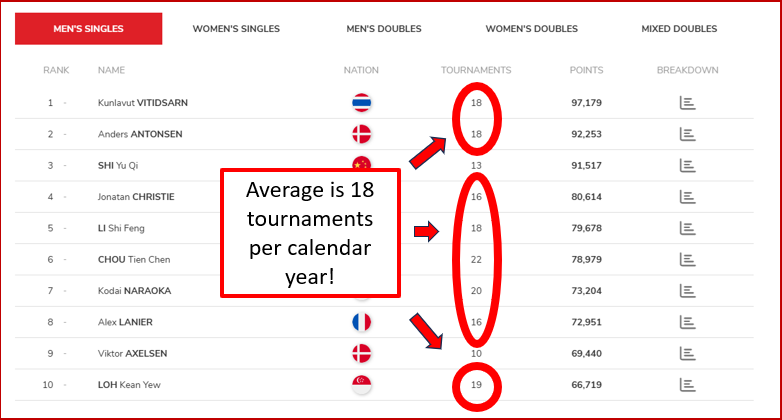I read an interesting article from the New Strait Times on BWF being greedy in terms of pushing the players into too many competitions. Here is the link to that article: I tend to disagree with that statement. Let’s discuss.
For top players, I believe in the top 15 for the singles disciplines, the players are required to compete in all 4 Super 1000 tournaments, 6 out of the 8 Super 750 tournaments, and 2 Super 500 tournaments. This makes a total of 12 mandatory tournaments. And, for world ranking calculations, the points from the players top 12 tournaments in a calendar year are selected. And it matches with these 12 mandatory tournaments nicely.
These 12 tournaments are required for a player to maintain his or her ranking, so he or she will be required to compete in these 12 to maintain the ranking. Dropping out from the top ranks would allow for the flexibility to skip tournaments. But, any player who aspires to make it to the top ranks would be pushing it by competing in more tournaments anyway.
In tournaments, there is always an element of luck. Some times, the draw goes against you early, and you get your nemesis. Some times, you are not feeling well on that day. Some times, logistical challenges causes chaos. Or it could be just plain bad luck from acts of nature. There are many ways a player may not be able to perform well on that day.
Due to that element of luck, players then to put a buffer of playing in more tourmanents than the minimum of 12. From a statistics point of view, it would make sense to have a 50% buffer, so that means going for 18 tournaments to get good results for 12. Just look at the top ranking tables below:
The only players in the men’s singles top 10 ranking with around 12 tournaments or less are Shi Yuqi and Axelsen. We know Shi Yuqi was struggling with illness and injuries for the second half of last year. And Axelsen is out recovery from his back surgery. Other than that, everyone has been putting in an average of 18 tournaments a year. That is quite normal.

Even the women’s singles top 10 rankings shows a similar story. An Se Young has been out due to fatigue or injury. Yamaguchi just came back from injury. Chen Yufei took a break and just came back in February this year. Tunjung has been out injured and still out. Katethong too has been out injured. The other 5 players are averaging 18 tournaments too.
So, from this quick snapshot, it appears making the top players compete in a minimal 12 tournaments is not an issue. What I feel is an issue is that too many top tournaments are stacked too closely to each other. I have mentioned this in an earlier blog entry:
I feel that having many mid level tournaments at the Super 500 level and the Super 300 level are beneficial to badminton. The top players are only required to compete in the top level tournaments, which is logical as they are after all, top players. An abundance of mid level tournaments opens up opportunities to new players to come out. If there are too little mid level tournaments, we will run the risk of always seeing the top players winning everything.
With more mid level tournaments, young upcoming players have a chance to gain experience, and also gain ranking points. When they finally collected enough ranking points to compete in the top level tournaments, they would have also gain a lot of match experience, and hopefully are able to put up a good fight with the top players. Usually, we see a huge mismatch between top players and young upcoming players. The gulf is not in skills, physical strength or stamina. It was in match experience.
In the past, we have Lee Chong Wei and Lin Dan still winning the Super 1000 Malaysia Open at age 35 in 2018 and 2019 respectively. That might be an abnormally, after all, it is Lee Chong Wei and Lin Dan… But the point is, at that advanced age to have top players still dominating the top level tournaments, it just means that young players are not getting a chance to gain valuable experience.
Things have improved a lot since then as we are now seeing more young players emerging and winning mid level tournaments. Sometimes young players are able to win the top level tournaments too. This can only be good for badminton.
Of the many things I disagree with what BWF is doing, this one I am in full agreement with. In order for badminton to grow, we need more mid level tournaments. The top players must be required to play in the top level tournaments, otherwise, they are just Super 1000 in name, but Super 500 in quality.
However, the problem with fixture congestion must be addressed. It is not a good idea to have back to back Super 1000 and Super 750 tournaments. It would lower the quality of the subsequent tournaments.
That is it for this entry.
Until the next update, eat well, get plenty of rest, and keep the badminton going!
Berita Olahraga
News
Berita Terkini
Berita Terbaru
Berita Teknologi
Seputar Teknologi
Drama Korea
Resep Masakan
Pendidikan
Berita Terbaru
Berita Terbaru
Download Film
Gaming center adalah sebuah tempat atau fasilitas yang menyediakan berbagai perangkat dan layanan untuk bermain video game, baik di PC, konsol, maupun mesin arcade. Gaming center ini bisa dikunjungi oleh siapa saja yang ingin bermain game secara individu atau bersama teman-teman. Beberapa gaming center juga sering digunakan sebagai lokasi turnamen game atau esports.
